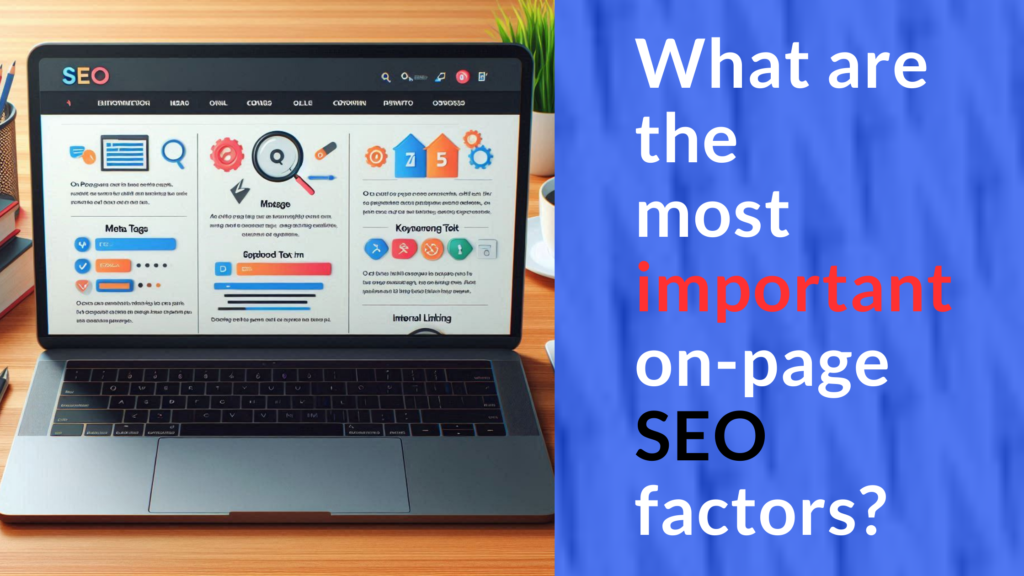In the dynamic world of digital marketing, on-page SEO remains a crucial component of any successful strategy. On-page SEO involves optimizing individual web pages to rank higher and earn more relevant traffic from search engines. But what are the most important on-page SEO factors that you should focus on? Let’s dive in.
1. High-Quality Content
Content is the cornerstone of on-page SEO. Search engines aim to deliver the most relevant and valuable content to users, so your content must be well-written, informative, and engaging. High-quality content is not just about keywords; it’s about providing value to your audience. Ensure your content is original, well-researched, and solves problems for your readers. Use a mix of text, images, videos, and infographics to make your content more engaging.
2. Keyword Optimization
While keywords have evolved over the years, they remain a vital part of on-page SEO. The key is to use them strategically. Start with thorough keyword research to identify the terms your audience is searching for. Then, integrate these keywords naturally into your content. Your primary keyword should appear in the title tag, meta description, headers, and throughout the content. However, avoid keyword stuffing, as it can lead to penalties from search engines.
3. Title Tags
The title tag is one of the most critical on-page SEO elements. It tells both search engines and users what your page is about. Your title tag should be concise, compelling, and include your primary keyword. Keep it under 60 characters to ensure it displays correctly in search engine results. A well-crafted title tag can significantly impact your click-through rate (CTR), so take the time to create an appealing one.
4. Meta Descriptions
Although meta descriptions do not directly affect rankings, they play a crucial role in driving clicks from search engine results pages (SERPs). A meta description should summarize the content of your page in 150-160 characters. It should be compelling, include your primary keyword, and encourage users to click on your link. A well-optimized meta description can improve your CTR, which is an important user engagement metric.
5. Header Tags
Header tags (H1, H2, H3, etc.) structure your content and make it easier for users and search engines to navigate. The H1 tag should include your primary keyword and accurately reflect the page’s main topic. Use H2 and H3 tags to organize subtopics and improve the readability of your content. Proper use of header tags helps search engines understand the hierarchy of your content, improving your chances of ranking for relevant keywords.
6. URL Structure
Your URL structure is another critical on-page SEO factor. Keep URLs short, descriptive, and include your primary keyword. A clean, easy-to-read URL is not only user-friendly but also helps search engines understand the context of your content. Avoid using numbers or special characters in your URLs, and use hyphens to separate words.
7. Internal Linking
Internal linking helps search engines crawl your website more effectively and improves the user experience. By linking to other relevant pages on your site, you can guide users to more valuable content and keep them on your site longer. Internal links also distribute link equity across your site, helping important pages rank higher in search results.
8. Image Optimization
Images are a vital part of engaging content, but they can also impact your site’s performance if not optimized correctly. Use descriptive file names and alt text that include your primary keywords. Compress images to reduce file size without sacrificing quality, which helps improve page load times—a crucial ranking factor.
9. Page Load Speed
Page load speed is a significant on-page SEO factor. Slow-loading pages can lead to higher bounce rates and lower user engagement. Search engines prioritize websites that load quickly, so optimizing your page speed is essential. Use tools like Google PageSpeed Insights to identify areas where you can improve, such as compressing images, leveraging browser caching, and minimizing JavaScript.
10. Mobile-Friendliness
With the majority of users now browsing on mobile devices, mobile-friendliness is no longer optional. Google’s mobile-first indexing means that the mobile version of your site is considered the primary version. Ensure your website is responsive, meaning it adjusts to different screen sizes and provides a seamless user experience across all devices.
Conclusion
On-page SEO is a multifaceted approach that requires attention to detail and a focus on providing value to users. By prioritizing high-quality content, keyword optimization, and technical factors like page speed and mobile-friendliness, you can improve your website’s visibility in search engine results and attract more relevant traffic. Remember, on-page SEO is not a one-time task but an ongoing process that requires regular updates and optimization to stay ahead in the competitive digital landscape.

